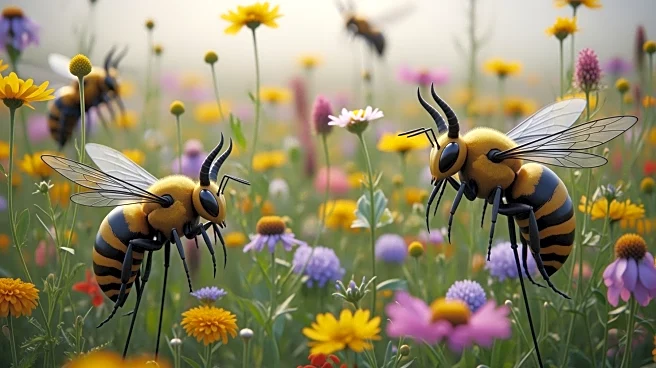What's Happening?
Researchers at Curtin University in Perth, Australia, have discovered a new bee species, Megachile lucifer, characterized by tiny 'devil-like horns.' The discovery was made while surveying a critically
endangered wildflower in the Bremer Range region. The bees were found in Western Australia's Goldfields, an area known for its rich biodiversity and mining activities. The female bees possess these unique horns, which are believed to serve adaptive functions such as defense against competitors and aiding in nest construction. The discovery highlights the importance of understanding native species before their habitats are disturbed by human activities.
Why It's Important?
The discovery of Megachile lucifer underscores the vast biodiversity that remains unexplored, particularly in regions threatened by mining and climate change. The Goldfields area, rich in gold reserves, faces habitat disturbance risks that could endanger both the newly discovered bee species and the wildflower it was found near. This finding emphasizes the need for comprehensive ecological surveys to protect native species and their ecosystems. The research also highlights the potential loss of biodiversity before it is fully understood, urging conservation efforts to prioritize habitat preservation.
What's Next?
The researchers stress the importance of conducting thorough surveys to identify native bee species and their ecological roles. As mining activities continue in the Goldfields, there is a pressing need to balance economic interests with environmental conservation. Future studies may focus on the ecological interactions between Megachile lucifer and its habitat, as well as the potential impacts of climate change on its survival. Conservationists and policymakers may need to collaborate to ensure sustainable practices that protect both the bees and the endangered wildflower species.
Beyond the Headlines
The discovery of Megachile lucifer raises ethical questions about the impact of human activities on biodiversity. The potential loss of unknown species due to habitat destruction calls for a reevaluation of environmental policies and practices. This case highlights the broader issue of biodiversity loss and the need for global efforts to preserve ecosystems. The unique characteristics of the bee also contribute to the understanding of evolutionary adaptations in insects, offering insights into the complex interactions within ecosystems.












